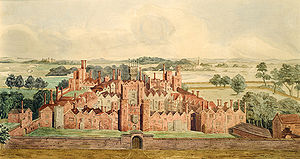- Oatlands Palace
-
Oatlands Palace is a former Tudor and Stuart royal palace located between Weybridge and Walton on Thames in Surrey, England. The surrounding modern district of Oatlands takes its name from the palace. Little remains of the original building, so excavations of the palace took place in 1964 to rediscover its extent.
Contents
The palace
Much of the foundation stone for the palace came from Chertsey Abbey which fell into ruins after the Dissolution of the Monasteries.[1]
Henry VIII acquired the house in 1538, and rebuilt it for Anne of Cleves. The palace was built around three main adjoining quadrangular courtyards covering fourteen hectares and utilising an existing 15th-century moated manor house.[2] He married Catherine Howard in the palace on 28 July 1540.[3]
It subsequently became the residence, at various times, of Mary I, Elizabeth I, James I and Charles I. It was to Oatlands that Mary Tudor retreated after acknowledging her "pregnancy" was phantom. Her previous residence Hampton Court Palace had housed the entire court and nursery staff that was assembled for the birth of the child. The announcement of a movement to Oatlands (considerably smaller than Hampton) ended any hope of a happy outcome of the Queen's pregnancy.
James I's wife Anne of Denmark employed Inigo Jones to design an ornamental gateway from the Privy Garden to the Park. In 1646, it was a temporary home of Princess Henrietta of England, daughter of Charles I of England and thus, grand-daughter of Anne of Denmark and King James I and sister-in-law of Louis XIV.
Charles used it for his queen's residence, employed John Tradescant the elder for its gardens, and was later imprisoned here by the army in 1647. After the King's execution the palace was sold and demolished, leaving a single house - remote from the site of the palace itself - that may have originally functioned as a hunting lodge.
The house
This was later occupied and extended by Sir Edward Herbert, the Lord Chief Justice, but was forfeited to the Crown when he followed James II into exile. It was then awarded to Arthur Herbert, 1st Earl of Torrington, who was the Admiral in command of the English and Dutch Fleets at the Battle of Beachy Head.
The house was again enlarged by the Duke of Newcastle, Henry Clinton, who laid out formal gardens.
In 1790, Oatlands was leased from the Crown by the Prince Frederick, Duke of York and Albany the second son of George III, and the subject of the nursery rhyme The Grand Old Duke of York.[4] His architect was Henry Holland.
In his second London notebook, composer Joseph Haydn recorded a two-day visit in November 1791. He says:
The little castle, 18 miles from London, lies on a slope and commands the most glorious view. Among its many beauties is a most remarkable grotto which cost £25 000 sterling, and which was 11 years in the building. It is very large and contains many diversions, inter alia actual water that flows in from various sides, a beautiful English garden, various entrances and exits, besides a most charming bath.
He was the guest of the Prince of Wales and the Duke of York, playing music for four hours each evening.[5]
The mansion and hotel
In 1794 the mansion was burnt down and was then rebuilt in the Gothic style of the period. After the death of the Duchess of York in 1820, the whole property was sold. It was bought by Edward Hughes Ball Hughes in 1824 (although it was not until after The Duke's death in 1827 that the sale was finally concluded) and again remodelled in 1830. Hughes had actually tried to dispose of the estate by public auction in 1829 but this part did not sell. He let the Mansion and the adjoining parkland to Lord Francis Egerton for a seven-year period in 1832 and renewed for a similar period in 1839. The arrival of the London and South Western Railway in 1838 made the area ripe for 'a daily commute to town' and in 1846 the estate was broken up into lots for building development and sold at three public auctions in May, August and September of that year. Following a period of private ownership by James Watts Peppercorne, the house became a hotel in 1856 known as the South Western (later Oatlands Park) Hotel.
From 1916 to 1918, during World War I, the hotel was used as a hospital for New Zealand troops injured in France.[6] Subsequently one of the main streets in Walton-on-Thames was renamed to New Zealand Avenue[7] in honour of these men.
The Oatlands Park Hotel now occupies the site where the Oatlands Mansion (Oatlands House) once stood, and there are still some elements of the earlier chapters of the house's existence visible within the core of the building. Contrary to claims sometimes made it is not on the site of the Oatlands Palace, which was situated further 'down the hill' in Weybridge. The hotel is rated 4 stars by the AA and 4 diamonds by the RAC.
References
- ^ Elmbridge museum
- ^ Oatlands Palace from the Gatehouse
- ^ Six wives of Henry VIII
- ^ Lock, A.H. (1974). Surrey in 1815. A picture of Surrey life in 1815. Reading: Osprey Publishing. ISBN 0850451795.
- ^ Robbins Landon, Howard Chandler (1959). The Collected Correspondence and London Notebooks of Joseph Haydn. London: Barrie and Rockliff.
- ^ "History". Oatlands Park Hotel. Archived from the original on 2008-02-23. http://web.archive.org/web/20080223095253/http://www.oatlandsparkhotel.com/datasite/oatlands_leisure/history.htm. Retrieved 2008-04-30.
- ^ New Zealand Avenue
External links
Coordinates: 51°22′30″N 0°26′33″W / 51.375072°N 0.442392°W
Categories:- Elmbridge
- Country houses in Surrey
- Tudor royal palaces in England
- Palaces in England
- Royal residences in the United Kingdom
- Royal residences in England
- Former palaces
Wikimedia Foundation. 2010.


